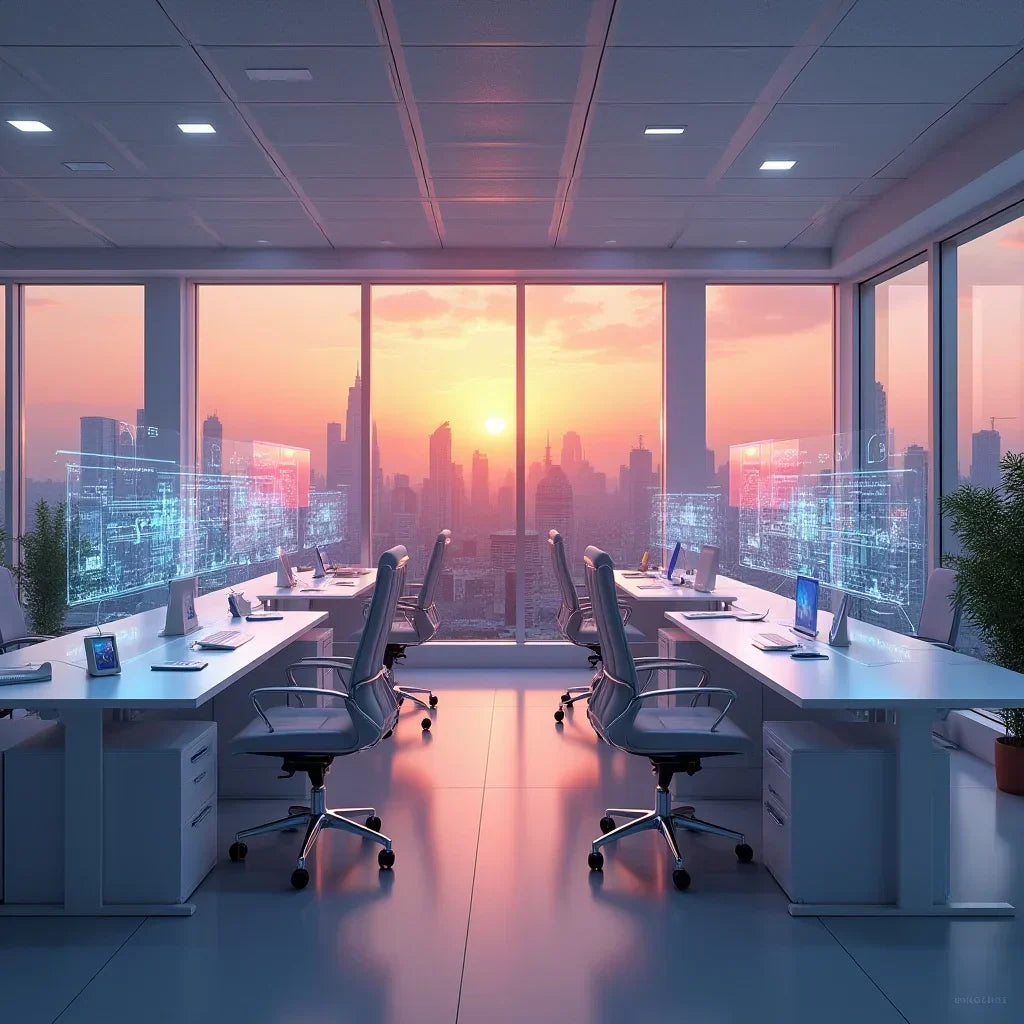Artificial in telligence (AI) is already transforming how we work. From productivity tools to project management systems, it’s everywhere. But while AI today optimizes how we perform tasks, tomorrow it will completely reshape our offices and workspaces.
By 2050, the future office will no longer be just a physical place—it will be a smart ecosystem capable of understanding, predicting, and adapting to human needs in real time.
So, what will this AI-imagined workspace of the future look like? We had fun imagining what it might look like in a not-so-distant future where design, technology, and sustainability come together to create a workspace more human than ever.
The Future Office: Predictive, Personalized, and Adaptive
Spaces Designed by Data and Emotion
By 2050, AI will not just assist employees—it will shape the spaces they work in. Algorithms will analyze work habits, postural data, and even emotional cues to tailor environments dynamically.
Imagine your workstation automatically adjusting its height and screen angle depending on your posture that day. Lighting, temperature, and background music will synchronize with your circadian rhythm.
These “sensitive offices” will become extensions of the human body and mind, anticipating needs before you’re even aware of them.
Workspaces That Learn from Their Users
Future workplaces will be equipped with learning systems. Through sensors and machine learning, offices will develop a kind of collective memory—remembering layout preferences, productivity peaks, and collaboration styles.
An intelligent control system could suggest reconfigurations based on current projects: expanding a collaborative area, adjusting lighting for focus sessions, or setting up immersive brainstorming environments—all autonomously.
The Alliance Between Design and Sustainability
Smart and Sustainable Materials
The office of the future will not only be intelligent—it will be eco-intelligent. AI will optimize energy consumption, reduce waste, and encourage the use of smart materials.
Imagine walls that clean themselves, regulate temperature, or absorb CO₂. Furniture will be crafted from biomaterials that evolve or regenerate over time.
Sustainability will no longer be an option—it will be built into the design DNA.
Spaces That Evolve Instantly
Static office layouts will be a thing of the past. The workspaces of 2050 will be modular and reconfigurable. Using AI-controlled mechanisms, partitions, tables, and seating can transform in seconds.
A meeting room can become a creative studio or a relaxation zone in moments. This intelligent flexibility will redefine efficiency, well-being, and the ability to adapt to changing needs.
Keeping Humans at the Center of Smart Workspaces
Work Environments that Care for Our Health
AI will enable continuous monitoring of employee well-being—tracking posture, visual fatigue, stress levels, hydration, and physical activity.
Gentle reminders will encourage movement, stretching, or breathing exercises throughout the day. Desks and chairs will become health partners rather than static objects
Connected applications will also monitor air quality, CO₂ levels, and natural light exposure to maintain a balanced and stimulating environment.
Boosting Creativity and Focus through Neuroergonomics
With advances in neuroergonomics, the office of the future will dynamically adjust its atmosphere to match concentration or creativity levels.
- Cool, blue-toned light and quiet environments for deep focus.
- Warm hues, ambient sound, and subtle scents for brainstorming sessions.
This emerging field—known as cognitive design—will become central to how office furniture and spaces are conceived
AI as the New Collaboration Partner
Virtual Assistants Integrated into Physical Spaces

Forget endless meetings and cluttered screens. By 2050, conference rooms will be equipped with collaborative AIs that summarize discussions, translate conversations in real time, and automatically generate meeting notes.
Holographic avatars will replace traditional video calls. Through mixed reality and motion sensors, remote colleagues will interact as if they were physically present—creating truly immersive hybrid work experiences.
Fostering Team Connection in a Hybrid World
Even in a world dominated by remote work, offices will remain essential as places of connection and collaboration.
The office will become a hub of creativity and belonging, where people come together to share ideas, innovate, and reconnect.
Immersive zones inspired by the metaverse will allow teams to co-create virtual prototypes and experiences. AI will orchestrate these interactions to enhance teamwork and collective intelligence.
When AI Becomes the Designer: The Rise of Algorithmic Aesthetics
Generative Design for Smarter Workspaces
Generative design, powered by AI, will revolutionize interior design and space planning. Algorithms will simulate hundreds of layout scenarios based on constraints like space, lighting, ergonomics, and style preferences.
Human designers will become co-creators alongside AI, guiding creativity while leveraging computational power.
The result: workspaces that are both intuitive and stunning, optimized for real human use rather than theoretical design.
Emotional Personalization
The future office won’t be impersonal or sterile. Each user will be able to customize their surroundings according to their mood, schedule, or goals.
Walls will shift colors, ambient projections will change themes, and even scents may evolve during the day.
Through emotion recognition, AI will turn the workspace into a living environment that mirrors its user’s energy—making work more pleasant and inspiring.
The Perfect Balance: Human, Technology, and Nature
While AI and technology will drive the transformation, the true challenge of 2050 will be to preserve the human essence of work.
Biophilic design—natural materials, daylight, and vegetation—will integrate with smart systems to create calm, regenerative spaces
The result: a connected biophilic office, blending invisible technology with visible well-being.
Conclusion: The Future Is Already Here
The AI-imagined office of 2050 is not just science fiction—it’s emerging right now. Adjustable desks, modular furniture, and smart lighting systems are only the beginning.
Tomorrow’s offices will represent a full fusion between artificial intelligence, sustainability, and human-centered design.
At Solutions M3, we believe the office of tomorrow begins with the choices we make today. Designing a smarter workspace isn’t about trends—it’s about investing in well-being, performance, and long-term sustainability.
FAQ – The Future Office and Artificial Intelligence
-
Q1. What is a smart office?
-
A smart office uses technology (AI, sensors, automation) to adapt the workspace to user needs, improving comfort, collaboration, and efficiency
-
Q2. How does AI influence office design?
-
AI analyzes spatial data and user behavior to optimize layouts, light, temperature, and acoustics for maximum productivity and comfort.
-
Q3. Will AI replace humans in the workplace?
-
No. AI is meant to support, not replace. Future design will enhance human creativity and well-being, not automate it away
-
Q4. What technologies will we find in 2050 offices?
-
Biometric sensors, augmented reality, smart materials, adaptive furniture, and embedded voice assistants integrated directly into the physical space.
-
Q5. How can companies start preparing now?
-
By adopting flexible, sustainable, and connected solutions—and working with partners who understand how technology and design can evolve together.


